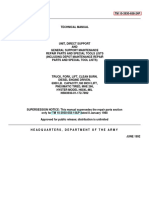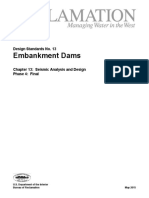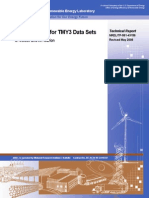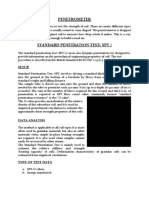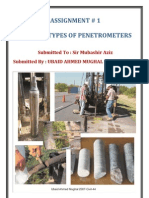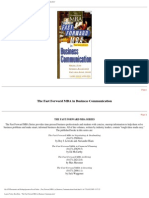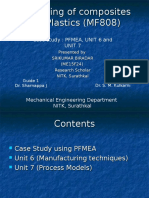Hand Held Electronic Cone Penetrometers For Measuring Soil Strength
Hand Held Electronic Cone Penetrometers For Measuring Soil Strength
Uploaded by
정관용Copyright:
Available Formats
Hand Held Electronic Cone Penetrometers For Measuring Soil Strength
Hand Held Electronic Cone Penetrometers For Measuring Soil Strength
Uploaded by
정관용Original Description:
Original Title
Copyright
Available Formats
Share this document
Did you find this document useful?
Is this content inappropriate?
Copyright:
Available Formats
Hand Held Electronic Cone Penetrometers For Measuring Soil Strength
Hand Held Electronic Cone Penetrometers For Measuring Soil Strength
Uploaded by
정관용Copyright:
Available Formats
United States
Department of
Agriculture
Forest Service
Technology &
Development
Program
2400 Timber
2500 Water and Air
December 2005
0524-2837-MTDC
Hand-Held Electronic
Cone Penetrometers for
Measuring Soil Strength
i
The Forest Service, United States Department of Agriculture (USDA), has developed this information
for the guidance of its employees, its contractors, and its cooperating Federal and State agencies, and
is not responsible for the interpretation or use of this information by anyone except its own employees.
The use of trade, rm, or corporation names in this document is for the information and convenience
of the reader, and does not constitute an endorsement by the Department of any product or service to
the exclusion of others that may be suitable.
The U.S. Department of Agriculture (USDA) prohibits discrimination in all its programs and activities
on the basis of race, color, national origin, age, disability, and where applicable, sex, marital status,
familial status, parental status, religion, sexual orientation, genetic information, political beliefs,
reprisal, or because all or part of an individuals income is derived from any public assistance program.
(Not all prohibited bases apply to all programs.) Persons with disabilities who require alternative
means for communication of program information (Braille, large print, audiotape, etc.) should contact
USDAs TARGET Center at (202) 720-2600 (voice and TDD). To le a complaint of discrimination,
write to USDA, Director, Ofce of Civil Rights, 1400 Independence Avenue, S.W., Washington, D.C.
20250-9410, or call (800) 795-3272 (voice) or (202) 720-6382 (TDD). USDA is an equal opportunity
provider and employer.
Soil penetrometers can help measure soil
strength. Forest management activities that
require the use of heavy equipment can
increase soil strength, making it difficult
for roots to grow.
Older mechanical cone penetrometers
traditionally used to measure soil strength
require two persons to operate.
Newer hand-held electronic cone
penetrometers can be operated by one
person and can probe 500 mm deep in
17 s, compared to about 5 min for a
dynamic cone penetrometer.
Gary Kees
Project Leader
USDA Forest Service
Technology and Development Program
Missoula, MT
2E22E60Soil Strength Tester
December 2005
Hand-Held Electronic
Cone Penetrometers for
Measuring Soil Strength
ii
Highlights ............... i
Acknowledgments ............................................................................................................................... ii
Introduction .......... 1
Typical Uses of Hand-Held Penetrometers ........................................................................................ 4
Operating and Testing Standards ....................................................................................................... 5
MTDC Penetrometer Evaluations at the Coeur dAlene Nursery ..................................................... 6
Models, Specications, and Prices ..........................................................................................................................6
Repeatability Tests ..................... 7
Side-by-Side Comparison Tests ...............................................................................................................................8
Other Equipment Options ................................................................................................................... 9
Discussions and Observations ........................................................................................................ 10
Recommendations ............................................................................................................................ 11
Penetrometer Contact Information .................................................................................................. 12
Contents
Acknowledgments
Leonard Roeber (deceased), Boise National Forest, Idaho City, ID
David Young, Pacic Southwest Research Station, Redding, CA
Richard E. Miller, Forestry Sciences Laboratory, Olympia, WA
Greg Ruark, USDA National Agroforestry Center, Normal, AL
Special thanks to the Coeur dAlene Nursery and to the equipment fabrication shop and
publications staff at MTDC.
1
Humans have been probing the ground since they could
hold sticks, but only in more recent times have their probes
been scientic. Researchers interested in studying soil
stratication probed the ground with pointed rods during
the early 1900s. A more rened instrument called a cone
penetrometer was invented in the Netherlands during the mid
1930s to measure soil strength.
Cone penetrometers measure soil penetration resistance
or soil strength encountered at various depths as a cone-
shaped object is pushed steadily into the ground. Advances in
electronics and software have expanded penetrometer func-
tions to include such features as moisture and temperature
sensors, soil structure analysis, video, and soil composition
analysis. These high-tech penetrometers are used mainly in
environmental and geotechnical site investigation. They are
large instruments, usually mounted on heavy-duty truck
frames or tracked vehicles (gure 1). The cones are driven
into the ground at consistent speeds to great depths.
Because these machines are too large and expensive
for simple eld applications, the Missoula Technology
and Development Center (MTDC) evaluated three hand-
held electronic cone penetrometers. Until recently, similar
penetrometers were comprised of a dial indicator with
a stress ring connected to a round rod with scaled depth
markings. The rod has a cone-shaped tip at one end and a
handle for pushing the cone into the ground on the other end
(gure 2). Using these penetrometers was a cumbersome
operation best completed by two people; one to push the
penetrometer into the ground and read the force on the dial
indicator, and the other to record probe depth and force.
Introduction
Figure 1This track-mounted, hydraulically driven soil penetrometer,
manufactured by AMS, Inc., is designed for environmental and
geotechnical site-investigation studies. (Photo courtesy of AMS, Inc.)
Handle
Dial
indicator
Stress
ring
Figure 2Mechanical cone penetrometers have been used for decades. A
dial indicator mounted inside a metal stress ring shows the force exerted on
the handle of this vintage penetrometer.
2
The hand-held electronic cone penetrometers evaluated
by MTDC (gure 3) can be operated by a single person. Each
model electronically records the force required to push the
probe into the ground and depth reading for computer down-
load and analysis. As the probe is pushed into the ground, the
force recorded by the electronic load cell is used to calculate
the cone index, a number derived from the frictional forces
on the cones surface as it is pushed into the ground. The
cone index is a relative indicator of the soils strength, typi-
cally recorded in kilopascals or pounds per square inch.
Figure 3The three hand-held electronic cone penetrometers tested by MTDC were the Rimik CP40 (left); the Eijkelkamp Penetrologger (center); and the
Spectrum Field Scout SC900 (right).
Metal
target
Metal
target
Metal
target
Metal
target
Rimik CP40
Spectrum Field
Scout SC900
Eijkelkamp Penetrologger
Metal
target
Metal
target
3
The penetrometer is able to calculate the probes depth
by determining the time it takes to bounce a signal from an
ultrasonic transducer off a metal target on the ground, and
back to the transducer (gure 4). A datalogger records the
soils strength and the probes depth. For accurate readings,
the penetrometer must be inserted into the ground at a steady
speed of about 30 mm/s.
GPS-
port
GPS
port
RS232-PC
download
port
RS232-PC
download
port
Ultrasonic
transducer
DC power
port
Reset
switch
Load
cell
Load
cell
DC power
port
Ultrasonic
transducer
Reset
switch
Probe cone Probe cone
Metal
target
Metal
target
Figures 4The operating components of a typical hand-held cone
penetrometer. The metal target bounces a signal back to the transducer,
allowing the penetrometer to calculate the probes depth. These photos
show the Rimik CP40.
4
Although penetrometers are very useful for certain
applications, the data show trends, but not exact measures
of soil density or compaction. The penetrometer provides
very accurate information on soil strength, or resistance to
penetration, to some depth. However, strength measurements
are affected by moisture, porosity, and rock content.
When combined with other information, such as soil
moisture, structure, and texture, data from penetrometers
can contribute to a more accurate picture of soil properties.
Typically, penetrometer readings taken in moist soils are
easier to acquire and give more meaningful information
than readings taken in dry, hard-packed soils. Penetrometers
are best suited for studying soil strengths (resistance to
penetration) in comparison studies between areas with
similar soil composition and moisture, or in one area where
impacts change over time, such as in areas that are farmed or
logged.
The agricultural industry has been a leader in using
electronic penetrometers. Forest tree nurseries could
benet from information provided by a penetrometer, such
as identication of areas of high compaction, plow pans,
and clay zones to help determine appropriate irrigation,
fertilization, and cultivation practices.
Soil compaction begins to inhibit the root growth of
most plants when the soils strength is about 1,500 kPa. The
roots of many plants quit growing when the soils strength
reaches about 2,500 kPa. Penetrometers can help identify
these areas faster and easier than standard bulk density
tests. More denitive soil testing may be required, but the
penetrometer can identify the problem areas.
MTDC initially investigated the use of hand-held
electronic cone penetrometers to evaluate how well
contractors were compacting the soil around bareroot
seedlings planted in holes drilled by augers at the Boise
Typical Uses of Hand-Held Penetrometers
National Forest in Idaho (gure 5). Planting contracts usually
specify that each planting hole be lled and compacted
by thirds rather than simply being lled and compacted.
Roots, rocks, sticks, gopher holes, voids, and the highly
compactable granitic soils in the Boise National Forest made
it difcult to identify the compacted layers. We concluded
that penetrometers are not practical for inspecting proper
compaction during tree-planting contracts.
Assessing the impact of logging operations on forest soil
compaction is important. Penetrometers may help soil scien-
tists and contracting ofcers verify that specications on soil
compaction limits are being followed. Indepth Forest Service
studies using hand-held electronic cone penetrometers during
logging operations have been conducted by the Forestry Sci-
ences Laboratory in Olympia, WA, and the Pacic Southwest
Research Station in Redding, CA.
Figure 5Penetrometer testing in the Boise National Forest near
Idaho City, ID.
5
The two main testing standards used in the United States
for the design and operation of penetrometers are set by the
American Society of Testing Materials (ASTM) and the
American Society of Agricultural Engineers (ASAE). ASTM
standards are used primarily for heavy, truck-mounted cone
penetrometers. The standards for hand-held penetrometers
are set by the ASAE. In agriculture and forestry applications,
the most common standards are: ASAE S313.3 February
2004, Soil Cone Penetrometer, and ASAE EP542 February
1999, Procedure for Using and Reporting Data Obtained
with the Soil Cone Penetrometer.
Operating and Testing Standards
ASAE standards require using a steel cylindrical cone
with a 30-degree tip. The diameter of the cone is 20.27 mm
for soft soils or 12.83 mm for hard soils. The cone should
be replaced when the wear exceeds 3 percent of the original
diameter. The shaft has a diameter of 15.88 mm for soft soils
or 9.53 mm for hard soils.
The amount of force exerted over the cones surface area
is called the Cone Index or CI, typically recorded in units of
kilopascals or pounds per square inch. The cone should be in-
serted into the ground at a steady rate of about 30 mm/s. It takes
practice to become consistentespecially in soil with varying
compaction, moisture, types, textures, structures, and voids.
6
CP40 Penetrologger Field Scout SC900
Manufacturer Agridry Rimik PTY LTD Eijkelkamp Agrisearch Equipment Spectrum Technologies, Inc.
Units displayed Metric only Metric only Metric or English
Depth range 0600 mm (24 in) 0800 mm (32 in) 0450 mm (18 in)
Pressure range 05,500 kPa (798 psi) 010,000 kPa (1,450 psi) 07,000 kPa (1,000 psi)
Maximum force 75 kg (165 lb) 102 kg (225 lb) 95 kg (210 lb)
Datalogger capacity 772 without GPS,
(measurements) 2,047 500 579 with GPS
Weight 3.9 kg (8.6 lb) 2.9 kg (6.39 lb) 1.25 kg (2.75 lb)
Resolution
Depth 1 mm (0.04 in) 10 mm (0.39 in) 25 mm (1 in)
Pressure 1 kPa (0.15 psi) 1 kPa (0.15 psi) 35 kPa (5 psi)
Accuracy
Depth 1 mm (0.04 in) 10 mm ( 0.39 in) 12.5 mm ( 0.5 in)
Pressure 2.24 kPa (0.32 psi) 2.0 kPa (0.29 psi) 103 kPa (15 psi)
GPS compatible? Yes No Yes
Speed alarm Yes Yes No
Power (batteries) 6-V gel cell, rechargeable (2) D-size, nickel-cadmium (2) AA alkaline
Display Graphic LCD Graphic LCD 16 character, 2-line LCD
Warranty 6 mo 1 yr 1 yr
Cost (as of 3/15/2005) $5,100 (CP40II) $5,200 $1,495
MTDC evaluators completed side-by-side comparisons
of the three hand-held electronic cone penetrometers at
the Forest Services Coeur dAlene, ID, nursery in late
September 2004. These comparisons looked rst at how
consistently each piece of equipment recorded soil strength
and depth, then at the functionality, simplicity, operability,
software, hardware, and output of each penetrometer.
MTDC evaluators also compared hand-held electronic
cone penetrometers with two mechanical penetrometers:
the Compact-O-Gauge and a dynamic cone penetrometer.
MTDC does not specically endorse any of the equipment
MTDC Penetrometer Evaluations at the Coeur dAlene Nursery
Table 1Manufacturers, specications, warranties, and purchase prices for the three hand-held electronic cone penetrometers tested by MTDC. The
Rimik Model CP40, which was tested, has been replaced by the CP40II.
tested and did not test all hand-held electronic cone
penetrometers that are available.
The primary goal was to evaluate how well each
penetrometer recorded soil strength. MTDC purchased
two units, the Rimik CP40 and the Spectrum Field Scout
SC900. The Eijkelkamp Penetrologger was borrowed from
Soilmoisture Equipment Corp.
Models, Specications, and Prices
Table 1 shows the specications and costs of the three
hand-held electronic cone penetrometers tested by MTDC.
7
Repeatability Tests
Each penetrometer was tested for consistency in
recording soil strength and depth by probing the ground
in seven locations about 300 mm apart, while maintaining
the recommended probe insertion speed of 30 mm/s.
Figures 6, 7, and 8 show the results from each of the three
penetrometers. The top 100 mm of soil showed very little
resistance because the soil had been cultivated to this depth.
A hardpan layer is at a depth of 350 to 400 mm.
The Rimik CP40 results are the most consistent. The
graph of the Eijkelkamp Penetrologger test looks a little
erratic in the lower half of the soil prole. Results of the
Spectrum Field Scout SC900 appear smoother than those
of the Eijkelkamp Penetrologger, but the variability widens
below 200 mm. The depth range of the three tested units
varies from 450 to 800 mm as shown in table 1.
Figure 7Repetition testing of the Eijkelkamp Penetrologger. The rst
100 mm of soil was weak because of recent tillage in the test eld. The
Eijkelkamp Penetrologger displays metric units.
Figure 6Repetition testing of the Rimik CP40 shows the units
consistency in documenting soil strength at various depths. Even though
the runs were conducted about 300 mm from each other, some variation
in readings can be expected because of differences in ground conditions,
equipment tracks, and operator inconsistency. The Rimik CP40 displays
metric units.
0
1
0
0
2
0
0
3
0
0
4
0
0
5
0
0
6
0
0
0
1
,
0
0
0
2
,
0
0
0
3
,
0
0
0
4
,
0
0
0
5
,
0
0
0
6
,
0
0
0
7
,
0
0
0
8
,
0
0
0
Soil strength (kPa)
D
e
p
t
h
(
m
m
)
Run 1
Run 2
Run 3
Run 4
Run 5
Run 6
Run 7
Average
Rimik CP40
0
1
0
0
2
0
0
3
0
0
4
0
0
5
0
0
6
0
0
0
1
0
0
0
2
0
0
0
3
0
0
0
4
0
0
0
5
0
0
0
6
0
0
0
7
0
0
0
8
0
0
0
Soil strength (kPa)
D
e
p
t
h
(
m
m
)
Run 1
Run 2
Run 3
Run 4
Run 5
Run 6
Run 7
Average
Eijkelkamp Penetrologger
Figure 8Repetition testing of the Spectrum Field Scout SC900. The
SC900 outputs English or metric units.
0
1
0
0
2
0
0
3
0
0
4
0
0
5
0
0
6
0
0
0
1
,
0
0
0
2
,
0
0
0
3
,
0
0
0
4
,
0
0
0
5
,
0
0
0
6
,
0
0
0
7
,
0
0
0
8
,
0
0
0
Soil strength (kPa)
D
e
p
t
h
(
m
m
)
Run 1
Run 2
Run 3
Run 4
Run 5
Run 6
Run 7
Average
Spectrum Field Scout SC900
8
Side-by-Side Comparison Tests
In this test, several ags were set in a line about 3 m
apart at the Coeur dAlene Nursery. One probe insertion
was made within 300 mm of every ag using each
instrument. Figures 9 and 10 show the results of two side-
by-side comparisons. At each location, the overall trend in
soil strength is consistent among the penetrometers. The
Eijkelkamp Penetrologger appears to record slightly higher
soil strengths than the other two instruments.
Because of its rocky compacted soils, the Coeur dAlene
Nursery was not the best testing ground for studying the
consistency of penetrometer readings. It was a good testing
ground to show typical conditions and difculties that can
be encountered in eld conditions. Figure 11 shows that
at a depth of about 350 mm the Eijkelkamp Penetrologger
recorded higher soil strength than the graph can display.
Typically, such readings occur when the probe hits a rock.
Some areas of the nursery were so dry and compacted that
the probe couldnt even be inserted into the ground.
Figure 9In the side-by-side comparison test, all three penetrometers were
reasonably consistent. Probes were about 300 mm from each other.
Figure 10The results from this comparison test show less consistency,
probably because of variation in ground conditions, equipment tracks, or
operator inconsistency.
Figure 11This test shows some variation between the three units in the
side-by-side test. The wild jump in soil strength on the Eijkelkamp Penetro-
logger was caused by a rock or very hard object at a depth of about 350 mm.
0
1
0
0
2
0
0
3
0
0
4
0
0
5
0
0
6
0
0
0
1
,
0
0
0
2
,
0
0
0
3
,
0
0
0
4
,
0
0
0
5
,
0
0
0
6
,
0
0
0
7
,
0
0
0
8
,
0
0
0
Soil strength (kPa)
D
e
p
t
h
(
m
m
)
CP40
Penetrologger
Field Scout
0
1
0
0
2
0
0
3
0
0
4
0
0
5
0
0
6
0
0
0
1
,
0
0
0
2
,
0
0
0
3
,
0
0
0
4
,
0
0
0
5
,
0
0
0
6
,
0
0
0
7
,
0
0
0
8
,
0
0
0
Soil strength (kPa)
D
e
p
t
h
(
m
m
)
CP40
Penetrologger
Field Scout
0
1
0
0
2
0
0
3
0
0
4
0
0
5
0
0
6
0
0
0
1
,
0
0
0
2
,
0
0
0
3
,
0
0
0
4
,
0
0
0
5
,
0
0
0
6
,
0
0
0
7
,
0
0
0
8
,
0
0
0
Soil strength (kPa)
D
e
p
t
h
(
m
m
)
CP40
Penetrologger
Field Scout
9
Other hand-held equipment that has been studied or is
in use today includes two mechanical penetrometers: the
Compact-O-Gauge and the dynamic cone penetrometer. A
prototype of the Compact-O-Gauge was invented in 1991
by Greg Ruark, when he was a Forest Service researcher
in North Carolina. The device simulates an acceptable
vehicle pressure or load (as dened by contracts or other
specication). The device works well, but only when
assessing the top 200 mm of soil. In a recent conversation,
Greg Ruark thought the hand-held electronic cone
penetrometer could perform the same function as the
Compact-O-Gauge but at greater soil depths.
The dynamic cone penetrometer uses a slide hammer
dropped from a specic height to force a cone into the soil
(gure 12). The recorded depth of penetration, weight of the
Other Equipment Options
slide hammer, and drop height are used to calculate the soil
penetration resistance. Even though the two instruments func-
tion differently, MTDC conducted a quick side-by-side test of
the dynamic cone penetrometer and the GP40 electronic pen-
etrometer. Figure 13 shows the results. It takes about 5 min to
collect data for one 500-mm probe with the dynamic cone
penetrometer, compared to about 17 s with the electronic
penetrometer. Dynamic cone penetrometers range cost from
$1,200 to $2,500, depending on options and accessories.
Some other untested instruments include the Clegg
Impact Soil Tester, Humboldt GeoGauge, and the nuclear
density meter. Generally, these instruments just look at the
top 100 to 200 mm of soil.
Figure 13Relative differences between a hand-held electronic cone
penetrometer and a dynamic cone penetrometer.
0
1
0
0
2
0
0
3
0
0
4
0
0
5
0
0
6
0
0
0
1
,
0
0
0
2
,
0
0
0
3
,
0
0
0
4
,
0
0
0
5
,
0
0
0
Soil strength (kPa)
D
e
p
t
h
(
m
m
)
CP40
Dynamic
Figure 12The slide hammer on a dynamic cone penetrometer is dropped
from a given height for a given number of times and the probes depth is
recorded. This device is less expensive ($1,200 to $2,500) than the hand-
held electronic cone penetrometers, but it takes much longer to use in the
eld and the cone index must be calculated after use.
10
A penetrometers measurement of soil strength is very
sensitive to soil compaction. However, using strength data
for denitive interpretations of soil compaction requires
correlations to other standard compaction tests or additional
knowledge of soil moisture and soil characteristics. The
hand-held electronic cone penetrometer can help pinpoint
compaction problems that might require more extensive soil
testing. Its also useful for looking at variability or changes in
soil strength caused by equipment, vehicles, and foot trafc.
Researchers are evaluating ways to use hand-held electronic
cone penetrometers to help predict the likelihood of serious
compaction in susceptible areas.
Reliable data requires penetrometer operators to insert
the probe into the ground at a consistent speed. Certain
soil or sampling conditions can greatly alter penetrometer
readings and make them much less useful. An operators
eld notes are helpful when data require editing because
of unusual conditions, such as very rocky soils, large
roots, hardpans or plowpans, voids such as gopher holes
or large root channels, buried organic materials, and very
dry conditions. The repetition tests conducted during this
evaluation verify the need to probe several locations in a
given area to better understand variations in soil conditions
and operator inconsistency.
Vegetation growing near the soil surface can interfere
with the hand-held electronic cone penetrometers, causing
false depth readings. The Spectrum Field Scout SC900
reported errors, rejecting the le, when weeds, sticks, or
grasses were near the testing area. MTDC fabricated a
ground target (a piece of U-shaped metal), similar to the one
provided by Eijkelkamp and Agridry, to help reduce the error
messages on the Spectrum Field Scout SC900.
The graphic readouts on the Eijkelkamp Penetrologger
and the Rimik CP40 are useful in the eld. Both
penetrometers give an indication of the insertion speed so
the operator can speed up or slow down as necessary. If the
penetrometer is not inserted at the proper speed, the operator
has the option to reject or keep a specic le. The Rimik
CP40 can be programmed to a specic insertion speed,
sounding an alarm or rejecting data (based on the operators
preference) if the speed is not correct.
Discussions and Observations
The Spectrum Field Scout SC900 stops taking readings
and requires the operator to start over if the proper speed
is not maintained. This feature is frustrating because many
times operators can tell that they hit a void or rock and could
note this in a logbook. In tough conditions, it can be very
frustrating to get one complete full depth reading with the
Spectrum Field Scout SC900.
The probe on the Eijkelkamp Penetrologger was longer
and thinner than the probes on the other two units. This
variation allows for deeper depth recordings, but the probe
tends to bow in hard soils. Eijkelkamp offers a thicker rod,
but it requires using a larger diameter cone that is more
difcult to insert into compacted soils. In sandy or less
compacted soils, the larger cone provides a broader range of
testing capabilities.
Eijkelkamp recommends that the operator program a
eld plan with plot names, the number of measurements
per plot, and the penetrometer parameters before taking
readings. This programming is best done in the ofce using
a computer, but can also be done in the eld using the
Eijkelkamp Penetrometers touch screen. The Rimik CP40
and the Spectrum Field Scout SC900 simply assign a le
number as each probe insertion is completed.
Downloading information from the penetrometers to
a computer is reasonably easy for all three penetrometers.
Importing the information into spreadsheets is more difcult.
The data from the Spectrum Field Scout SC900 can be
downloaded as well-formatted text les that need very little
manipulation. Data from the Eijkelkamp Penetrologger and
the Rimik CP40 require more manipulation when they are
imported into a spreadsheet. We had to download each le
individually from the Rimik CP40 because information
could not be separated easily when more than one le was
downloaded at a time.
The Rimik CP40 and Spectrum Field Scout SC900
are designed to record location data from an external
GPS receiver (not provided) at each probe location. The
Eijkelkamp Penetrologger has no provisions for GPS.
Because only two units had GPS capabilities, the GPS option
was not tested by MTDC.
11
The Rimik CP40 seems to be the most practical hand-
held electronic cone penetrometer of the three tested. It has
the most data storage, provides a comfortable operating
height, and performed well in the repeatability testing. The
newest version is called the Rimik CP40II. The manufacturer
says that the software for data manipulation has been
improved. The updated model costs $5,100, about as much as
the $5,200 Eijkelkamp Penetrologger.
Recommendations
If budget is the deciding factor, the Spectrum Field Scout
SC900 provides accurate data and costs just $1,495. Expect
to spend a lot longer in the eld trying to collect information
because of the Spectrum Field Scout SC900s rejection of
all data whenever the probe is inserted too quickly or too
slowly.
12
Penetrometer Contact Information
Model: CP40 and CP40II
Manufacturer: Agridry Rimik PTY LTD
Sales Representative: Soil Measurements System
Contact: Annmarie Wierenga
7090 North Oracle Rd. No. 178170
Tucson, AZ 85704
Phone: 5207424471
Fax: 5205442192
E-mail: sales@soilmeasurement.com
Web site: http://www.soilmeasurement.com
Model: Field Scout SC900
Manufacturer: Spectrum Technologies, Inc.
Sales Representative: Spectrum Technologies, Inc.
Contact: Doug Keiffer
23839 West Andrew Rd.
Plaineld, IL 60544
Phone: 8154364440
Fax: 8154364460
E-mail: info@specmeters.com
Web site: http://www.specmeters.com
Model: Penetrologger
Manufacturer: Eijkelkamp Agrisearch Equipment
Sales Representative: Soilmoisture Equipment Co.
Contact: Megan Cullen
801 South Kellogg Ave.
Goleta, CA 93117
Phone: 8059643525
Fax: 8056832189
E-mail: sales@soilmoisture.com
Web site: http://www.soilmoisture.com
Other Contacts
David Young, Soil Scientist
Pacic Southwest Research Station
2400 Washington Ave.
Redding, CA 96001
Phone: 5302262545
E-mail: daveyoung@fs.fed.us
1
Gary Kees is a project leader specializing in reforestation and nurseries, facilities, recreation, and GPS
projects at MTDC. He received his bachelors degree in mechanical engineering from the University of Idaho.
Before coming to MTDC in 2002, Gary worked for the Monsanto Co. in Soda Springs, ID, as a mechanical/
structural engineer and project manager.
About the Author
Library Card
Kees, Gary. 2005. Hand-held electronic cone penetrometers for measuring soil strength. Tech. Rep.
05242837MTDC. Missoula, MT: U.S. Department of Agriculture Forest Service, Missoula Technology and
Development Center. 12 p.
Describes tests comparing three hand-held electronic cone penetrometers: the CP40 (Agridry Rimik PTY
LTD, $5,100 for the newer CP40II), the Field Scout SC900 (Spectrum Technologies, Inc., $1,495), and the
Penetrologger (Eijkelkamp Agrisearch Equipment, $5,200). Cone penetrometers are used to measure soil strength,
which can be a concern during forest management activities that require the use of heavy equipment. A traditional
mechanical penetrometer requires two persons to operate. Dynamic cone penetrometers take about 5 minutes to
probe 500 millimeters deep. Newer electronic cone penetrometers that can be operated by one person probe 500
millimeters deep in just 17 seconds. These penetrometers can locate areas with excess soil strength, but they do
not provide denitive measurements of soil compaction. The CP40 appeared to be the most practical of the three
penetrometers tested. It had the most storage for data, a comfortable operating height, and performed well in
repeatability testing.
Keywords: comparisons, equipment, nurseries, reforestation, soil compaction, soil mechanics, soil physical
properties, soil strength, soil testing
Single copies of this document may be ordered from:
USDA Forest Service, MTDC
5785 Hwy. 10 West
Missoula, MT 598089361
Phone: 4063293978
Fax: 4063293719
E-mail: wo_mtdc_pubs@fs.fed.us
For additional technical information, contact Gary Kees
at MTDC.
Phone: 4068296753
E-mail: gkees@fs.fed.us
Electronic copies of MTDCs documents are available on
the Internet at:
http://www.fs.fed.us/eng/t-d.php
Forest Service and Bureau of Land Management
employees can search a more complete collection of
MTDCs documents, videos, and CDs on their internal
computer networks at:
http://fsweb.mtdc.wo.fs.fed.us/search/
You might also like
- Hyster H 60 XL SHOP MANUALDocument273 pagesHyster H 60 XL SHOP MANUALjacksonholland833586% (7)
- Imagery and GIS: Best Practices for Extracting Information from ImageryFrom EverandImagery and GIS: Best Practices for Extracting Information from ImageryRating: 4 out of 5 stars4/5 (1)
- Sperry Sun - LWD and LWD ServicesDocument8 pagesSperry Sun - LWD and LWD ServicesBAS100% (1)
- Sop SertuDocument4 pagesSop SertuMohamad Firdaus Mohamad Halimi100% (4)
- Soil PercolationDocument39 pagesSoil PercolationAruna BandaraNo ratings yet
- USDA Soil Report: Antelope County, NEDocument94 pagesUSDA Soil Report: Antelope County, NEhefflingerNo ratings yet
- The EPRI Zed-MeterDocument82 pagesThe EPRI Zed-Metershawnr7376No ratings yet
- 1 How Much Would Zoe A Receive in Initial LoanDocument2 pages1 How Much Would Zoe A Receive in Initial Loantrilocksp SinghNo ratings yet
- Nashik Midc ListDocument6 pagesNashik Midc ListAmol Gadkar71% (28)
- Basic Interview Skills PDFDocument2 pagesBasic Interview Skills PDFRaguNo ratings yet
- New Inexpensive Dendrometers For Monitoring Crop Tree GrowthDocument24 pagesNew Inexpensive Dendrometers For Monitoring Crop Tree GrowthJuan DetemNo ratings yet
- CALIBRATION OF A MANUAL CONE PENETROMETER USING A DIGITAL PENETROLOGGER KasaliDocument9 pagesCALIBRATION OF A MANUAL CONE PENETROMETER USING A DIGITAL PENETROLOGGER KasaliAnkit ChoudharyNo ratings yet
- Manual Earth Tomo 2 USGovDocument1,278 pagesManual Earth Tomo 2 USGovosp_tigre100% (3)
- 3-TP 507 CSM Field Virus LTRRPT FinalDocument33 pages3-TP 507 CSM Field Virus LTRRPT Finaltvb7tcy7c9No ratings yet
- S822, S823 DesignDocument37 pagesS822, S823 DesignJair Sanches OsorioNo ratings yet
- USBR Seismic Analysis and Design of DamsDocument352 pagesUSBR Seismic Analysis and Design of DamsTimbo6808No ratings yet
- NRSC 18 - Flyer - UIM2014 - US2 - Genesys PDFDocument19 pagesNRSC 18 - Flyer - UIM2014 - US2 - Genesys PDFAshoka VanjareNo ratings yet
- Introduction To Grounding AnalysisDocument30 pagesIntroduction To Grounding AnalysisGustavo CariniNo ratings yet
- SRS/MKS: Department of Aeronautical Engineering Study MaterialsDocument74 pagesSRS/MKS: Department of Aeronautical Engineering Study MaterialsRAJASUDHAKAR SNo ratings yet
- Pub 106357Document34 pagesPub 106357bazzaNo ratings yet
- Mini Disk Infiltrometer - WebDocument24 pagesMini Disk Infiltrometer - WebMajitoJaramilloNo ratings yet
- Annular Space ReportDocument50 pagesAnnular Space ReportAnonymous T32l1RNo ratings yet
- Expert System 36Document40 pagesExpert System 36Tech MasterNo ratings yet
- Application and Assessment of Precision Deep TillageDocument16 pagesApplication and Assessment of Precision Deep TillageRonald LeichtleNo ratings yet
- Design and Fabrication of A Portable Resistivity Meter For Ground Water ExplorationDocument5 pagesDesign and Fabrication of A Portable Resistivity Meter For Ground Water Explorationumaryunusa3410No ratings yet
- Manual de Usuario Medidor de Resistencia Analógico Miller 400 - IngDocument17 pagesManual de Usuario Medidor de Resistencia Analógico Miller 400 - IngDiego Fernando HenaoNo ratings yet
- Free African Football Academy Sitting Report and 8 BH Drilling EstimateDocument14 pagesFree African Football Academy Sitting Report and 8 BH Drilling EstimateEvans Vakpo kofiNo ratings yet
- RammedEarth PDFDocument42 pagesRammedEarth PDFNupur BhadraNo ratings yet
- Minasny & Hartemink (2011)Document11 pagesMinasny & Hartemink (2011)Sâmala Carneiro SilvaNo ratings yet
- CV 321 - Lab 1 - DCP - FinalDocument5 pagesCV 321 - Lab 1 - DCP - Finals11197376No ratings yet
- Calibration of W ! Ermark Soil Moisture Sensors For Irrigation ManagementDocument9 pagesCalibration of W ! Ermark Soil Moisture Sensors For Irrigation ManagementadnanNo ratings yet
- Technical Manual For The Geospatial Stream Flow ModelDocument69 pagesTechnical Manual For The Geospatial Stream Flow ModelNelson NhamirreNo ratings yet
- Benefits of The Dilatometer TestDocument5 pagesBenefits of The Dilatometer Testkaleswara_tellakulaNo ratings yet
- Radar Cross Section of Triangular Trihedral Re Ector With Extended Bottom PlateDocument39 pagesRadar Cross Section of Triangular Trihedral Re Ector With Extended Bottom PlateTanvi AgrawalNo ratings yet
- Dempster-Shafer Theory Combination RuleDocument96 pagesDempster-Shafer Theory Combination RuleLidusis ArtianNo ratings yet
- Chapter 4Document7 pagesChapter 4debepi17No ratings yet
- Wind Turbine Modeling For Computational Fluid Dynamics: December 2010 - December 2012Document57 pagesWind Turbine Modeling For Computational Fluid Dynamics: December 2010 - December 2012Ryan RebelloNo ratings yet
- TMY3Document58 pagesTMY3Hicham BidaouiNo ratings yet
- Foundation Testing Data Sheet 1 Pile Integrity Testing - TDR MethodDocument5 pagesFoundation Testing Data Sheet 1 Pile Integrity Testing - TDR MethodNishit PatelNo ratings yet
- Towards The Development of A Sensor For Measuring Soil Stresses in The Cyclic Simple Shear ApparatusDocument326 pagesTowards The Development of A Sensor For Measuring Soil Stresses in The Cyclic Simple Shear ApparatusTiago SchuckNo ratings yet
- An Analysis of The Madaras Rotor Power Planta - Alternate Method For Extracting Large Amounts of Power From The Wind - Vol 2Document427 pagesAn Analysis of The Madaras Rotor Power Planta - Alternate Method For Extracting Large Amounts of Power From The Wind - Vol 2binho58No ratings yet
- Soil Electrical Conductivity PDFDocument6 pagesSoil Electrical Conductivity PDFWahyu OctavianusNo ratings yet
- Design and Analysis of Disc Plough For Agricultural IndustryDocument12 pagesDesign and Analysis of Disc Plough For Agricultural Industryሐይማኖቴ ህያዉ ናት100% (1)
- Melt Spreading and QuenchingDocument55 pagesMelt Spreading and QuenchingAya DiabNo ratings yet
- Stability Analysis of Earth Dam by GeostudioDocument10 pagesStability Analysis of Earth Dam by GeostudioIAEME PublicationNo ratings yet
- Monier-Williams Et Al., 2009. Review of Borehole Based Geophysical Site Evaluation Tools and TechniquesDocument188 pagesMonier-Williams Et Al., 2009. Review of Borehole Based Geophysical Site Evaluation Tools and TechniquesmOchONo ratings yet
- Foundation Design From Dynamic Penetration TestDocument42 pagesFoundation Design From Dynamic Penetration Testmlakkiss100% (2)
- Characterization Undrained Shear Strength Clay TexasDocument159 pagesCharacterization Undrained Shear Strength Clay TexasMauricio Cruz GonzálezNo ratings yet
- A Comparison of Horizontal HydraulicDocument12 pagesA Comparison of Horizontal HydraulicChidiOkoloNo ratings yet
- GDTE enDocument84 pagesGDTE enNga VũNo ratings yet
- Casos de UsoDocument11 pagesCasos de UsoIvan FritzNo ratings yet
- 2.500 Desalination and Water Purification: Mit OpencoursewareDocument55 pages2.500 Desalination and Water Purification: Mit OpencoursewareMilagros Estefania Rosas Nuñez-DuffooNo ratings yet
- Medidor Landys GyrDocument154 pagesMedidor Landys GyrJoa Marin100% (1)
- Geotechnical Engineering Circular No. 5Document386 pagesGeotechnical Engineering Circular No. 5Ay Ch100% (1)
- Geotechnical InvestigationsDocument7 pagesGeotechnical InvestigationsBilal Ali Syed100% (1)
- Types of Penetrometers.. (Ubaid Ahmed Mughal)Document8 pagesTypes of Penetrometers.. (Ubaid Ahmed Mughal)Ubaid Ahmed MughalNo ratings yet
- Instruments, Measurement Principles and Communication Technologies for Downhole Drilling EnvironmentsFrom EverandInstruments, Measurement Principles and Communication Technologies for Downhole Drilling EnvironmentsNo ratings yet
- CartoMobile iPhone/iPad App: Optimize Ground Survey Data Collection for Airborne LIDAR Accuracy AssessmentFrom EverandCartoMobile iPhone/iPad App: Optimize Ground Survey Data Collection for Airborne LIDAR Accuracy AssessmentNo ratings yet
- Lesson 2Document8 pagesLesson 2정관용No ratings yet
- Issue 58Document16 pagesIssue 58정관용No ratings yet
- (Leavitt - A) LEARNING FROM VISUALS - How Well-Designed and Well-Used Visuals Can Help Students LearnDocument26 pages(Leavitt - A) LEARNING FROM VISUALS - How Well-Designed and Well-Used Visuals Can Help Students Learn정관용No ratings yet
- Digital Elevation Model (DEM) WhitepaperDocument120 pagesDigital Elevation Model (DEM) Whitepaper정관용No ratings yet
- Code EcospatDocument49 pagesCode Ecospat정관용No ratings yet
- Multi Variate AnalysisDocument53 pagesMulti Variate Analysis정관용No ratings yet
- 600542-E AgriSpec User ManualDocument72 pages600542-E AgriSpec User Manual정관용No ratings yet
- (USDA) The Forest Inventory and Analysis DatabaseDocument344 pages(USDA) The Forest Inventory and Analysis Database정관용No ratings yet
- Rexercises 1 R BasicDocument35 pagesRexercises 1 R BasicJohn StephenNo ratings yet
- A Little Book of R For Time SeriesDocument75 pagesA Little Book of R For Time Series정관용No ratings yet
- Bayesian ProgrammingDocument208 pagesBayesian Programming정관용100% (5)
- Background - Instantaneous Release: Problems - Enviroland - GroudwaterDocument10 pagesBackground - Instantaneous Release: Problems - Enviroland - Groudwater정관용No ratings yet
- (FAO, 2004) Guiding Principles For The Quantitative Assessment of Soil DegradationDocument73 pages(FAO, 2004) Guiding Principles For The Quantitative Assessment of Soil Degradation정관용No ratings yet
- Visjet User ManualDocument45 pagesVisjet User Manual정관용No ratings yet
- Radar Cross Section Reduction: April 2013Document17 pagesRadar Cross Section Reduction: April 2013Ahmed RamiNo ratings yet
- MCQ On Fuel CellDocument6 pagesMCQ On Fuel CellRohini HaridasNo ratings yet
- Legal Framework of Land Reform in IndiaDocument3 pagesLegal Framework of Land Reform in IndiaLund PratapNo ratings yet
- Green HRMDocument8 pagesGreen HRMdev kakkarNo ratings yet
- Rotary Dryer BrochureDocument1 pageRotary Dryer Brochurejanob7No ratings yet
- Case Background: Setup Problem ObjectiveDocument3 pagesCase Background: Setup Problem ObjectiveBhaveek OstwalNo ratings yet
- Quiz 4 5 CfasDocument8 pagesQuiz 4 5 CfasDan Edriel RonabioNo ratings yet
- Please Succ Me ' (Document1 pagePlease Succ Me ' (;(No ratings yet
- C15 Acert: Industrial Caterpillar Engine SpecificationsDocument4 pagesC15 Acert: Industrial Caterpillar Engine Specificationsyash singhNo ratings yet
- Indian Standard - Code For Hygienic Conditions For Sugar FactoriesDocument11 pagesIndian Standard - Code For Hygienic Conditions For Sugar FactoriesRavi ChandarNo ratings yet
- RecitationDocument4 pagesRecitationSavaliya HardikNo ratings yet
- Fast Forward MBA - Business CommunicationsDocument175 pagesFast Forward MBA - Business Communicationsapi-27288526100% (1)
- The Study On Selection and RecruitmentDocument49 pagesThe Study On Selection and Recruitmentpravallikavishnu28No ratings yet
- MESSAD E-TicketDocument1 pageMESSAD E-TicketSelahattin HakanNo ratings yet
- Meralco v. La CampanaDocument10 pagesMeralco v. La CampanaMarie Melanie BuenaventuraNo ratings yet
- Hull Coatings For Vessel PerformanceDocument94 pagesHull Coatings For Vessel Performancescribdtaker12345100% (5)
- FAR610 - FAR620 - Q - Test 1 MAY 2023Document5 pagesFAR610 - FAR620 - Q - Test 1 MAY 20232021887488No ratings yet
- Insurance LawDocument24 pagesInsurance Lawfekadu bayisa100% (1)
- FMEA Chapter 6 and 7 SlidesDocument32 pagesFMEA Chapter 6 and 7 SlidesShree BiradarNo ratings yet
- TSM 21 Diagnostic FullDocument63 pagesTSM 21 Diagnostic FullAdam StroufNo ratings yet
- Vibration With ControlDocument21 pagesVibration With ControlhamidrezachamaniNo ratings yet
- Dagr LGRDocument2 pagesDagr LGRtomay777No ratings yet
- 123 Impact of Family Pressure To The Academic Performance of StudentsDocument29 pages123 Impact of Family Pressure To The Academic Performance of StudentsJeneffer Estal Fraga100% (1)
- Arch Drawings Manual DrafDocument107 pagesArch Drawings Manual DrafrapfttNo ratings yet
- Antioxidante (BHT)Document3 pagesAntioxidante (BHT)Frank Otihua LaosNo ratings yet
